Ready to drive incremental growth with influencers?
If ditching the randomness of influencer campaigns and building a predictable, ROI-first influencer program sounds like a plan. Consider talking to our team!

Meta
Influencer gifting is a cost-effective way to spark authentic content and build creator relationships. This guide explores strategic approaches to gifting.
Contents
Most influencer gifting is dead on arrival. A beige box. A thank-you card no one reads. A product they didn’t ask for. And then brands wonder why no one posts.
Influencer gifting, when done right, should feel like a friend sent something. That is the bar now. And if your gifts aren’t getting unboxed on stories or ranted about on TikTok… congrats, you just ran a charity, not a campaign.
That is exactly why we put this together. And no, we won’t recycle basic advice. These are 11 influencer gifting strategies no one is really saying out loud, but they are the ones actually getting engagement.

Influencer gifting is when a brand sends free products or services to a content creator with the hope that they will feature it on their social media channels. There is usually no formal contract or monetary compensation – just the product and an informal expectation of coverage.
Here’s how it typically works:
The influencer may create content about it, usually on Instagram Stories, TikTok, or YouTube though it is never guaranteed unless agreed in advance.
Some gifting programs include usage guidelines, hashtags, or brand mentions, but unless it is a paid collaboration, influencers can decide how and whether to post.
This method helps brands reach potential customers at a lower cost as compared to paid sponsorships. It is most effective when done strategically, by targeting influencers who already like similar products and are likely to share them organically.
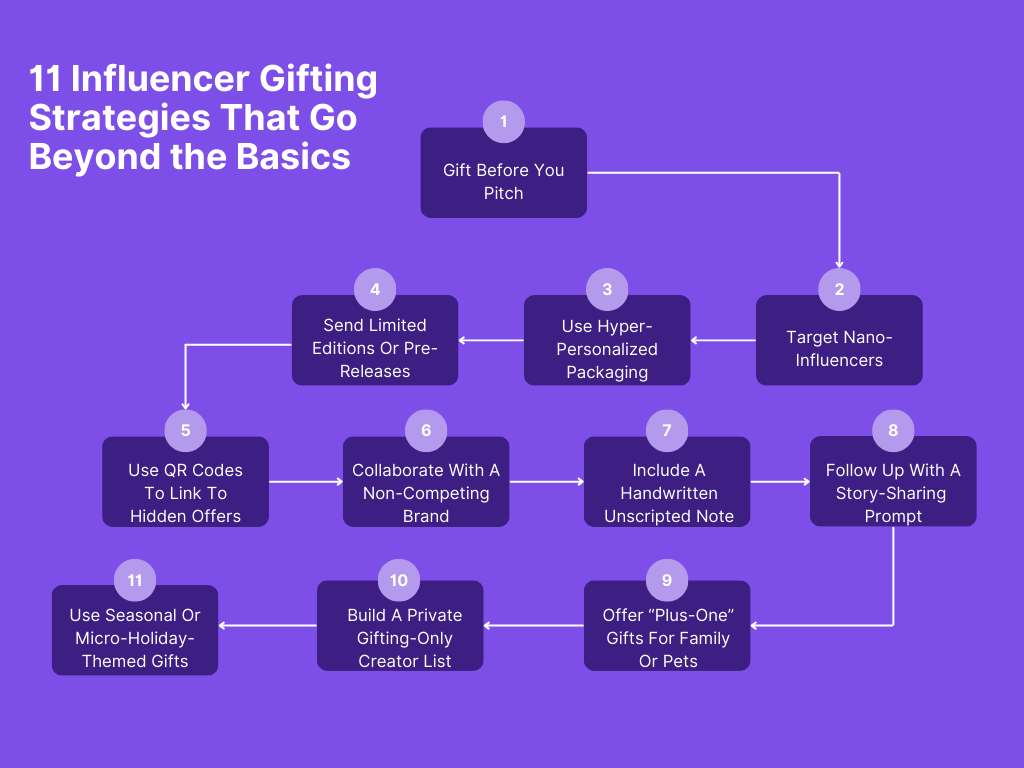
Most influencers giving advice is the same: send a product and hope for a tag. That might have worked years ago, but if you want real engagement today, you need to think differently. Here are 11 strategies that go beyond the basics and get creators excited to post.
Most brands do it backwards. They send a DM saying, “Hey! Can we send you something?” and wait for a yes. The problem is that by then, it already feels transactional.
Now reverse it. Send the gift before you ever ask for anything. No strings. No pitch. Just “Saw your content, thought you’d love this.” It instantly shifts the dynamic. You are not a brand asking for something you are a fan giving value.
The result? The influencer is surprised. They are curious. And more often than not, they will share content about it organically without you even asking. When you follow up later with a real pitch, they already feel like they owe you one.
Try this:
Don’t sleep on small creators. Nano-influencers (typically under 10K followers) have insanely tight-knit communities. Their audiences actually trust them, like “I bought this because you said so” level trust.
These influencers don’t get bombarded with PR gifts, so your package actually stands out. And because they are closer to their followers, the engagement they get is way more meaningful than what you would get from macro influencers. In fact, they have the highest average engagement rate at 2.19%.
Also, they are way more likely to post and build an ongoing relationship with your brand.
Try this:
Now you can skip all this hassle by using SARAL. It starts with a powerful discovery engine (just use a Chrome extension) that helps you find nano and micro-influencers by niche, see their engagement data, and segment them into clean lists.
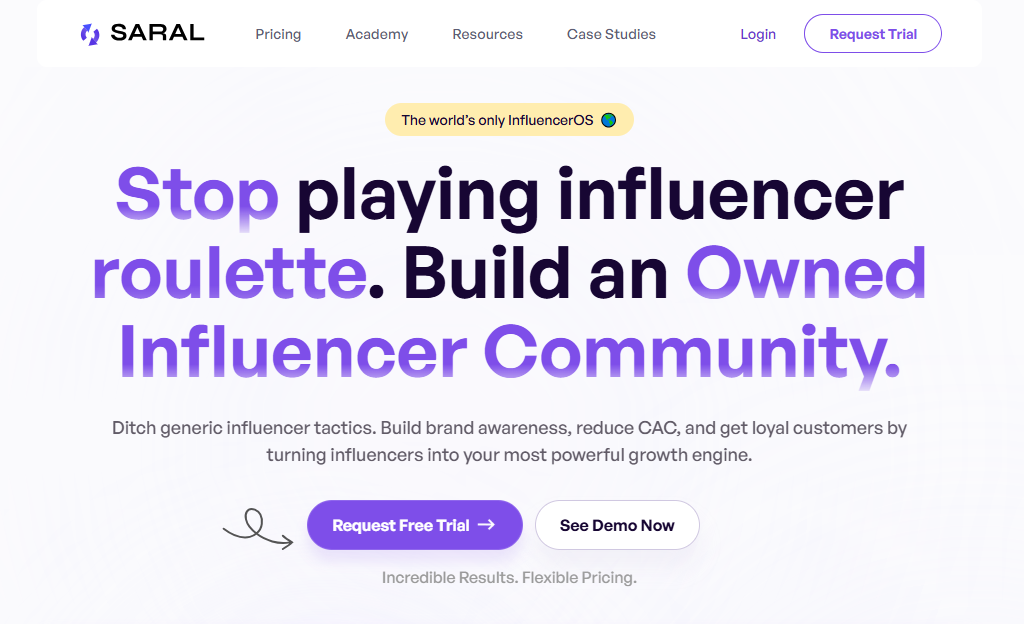
Outreach is no longer a blind shotgun: you can:
Once you have sent your gifts, SARAL tracks it all: who posted, how their social media posts performed, and even pulls in UGC automatically into a central dashboard
Plus, it helps you build long-term relationships, not just one-offs. CRM-style reminders make sure you never forget a follow-up. Then you can use Lookalikes AI to find even more creators like your top performers in seconds.
This one is underrated. The outside of the box is your first impression. If it looks like a generic mailer, it is dead on arrival. But it can be a total win if it feels like it was made just for them.
We are talking about packaging that references their content or includes an inside joke only their followers would get. It instantly makes the gift feel special, and that is what gets you posts.
Even better, influencers love showing packaging. The more creative or personal it is, the more likely they will film it.
Try this:
If your product is already out, it is old news. But if you are sending something before it drops, or that no one else can get yet, it creates immediate buzz. Influencers understand how important it is to be first. Their audience loves that too.
It makes them feel like insiders. They get to say, “This isn’t even out yet,” which makes the influencer content more clickable and more shareable.
Even if you are not launching something new, create a “limited edition” version just for gifting. A special label or color can make it feel exclusive.
Try this:
Let’s pause here because one brand doing this so right is Transparent Labs.
You won’t see them flooding Instagram with random product seeding. Instead, they are getting super smart with how they make influencers use creatine supplements.
Here’s what they do right: instead of blasting out their regular lineup, they occasionally release limited-edition flavors and send them out to a tight list of fitness creators before anyone else even hears about it.
By letting creators get early access to something exclusive, they give them a reason to talk about creatine again. Even if creators have mentioned it before, a limited edition is newsworthy. It is a chance to post a quick reel, an unboxing, a “taste test” in a story.
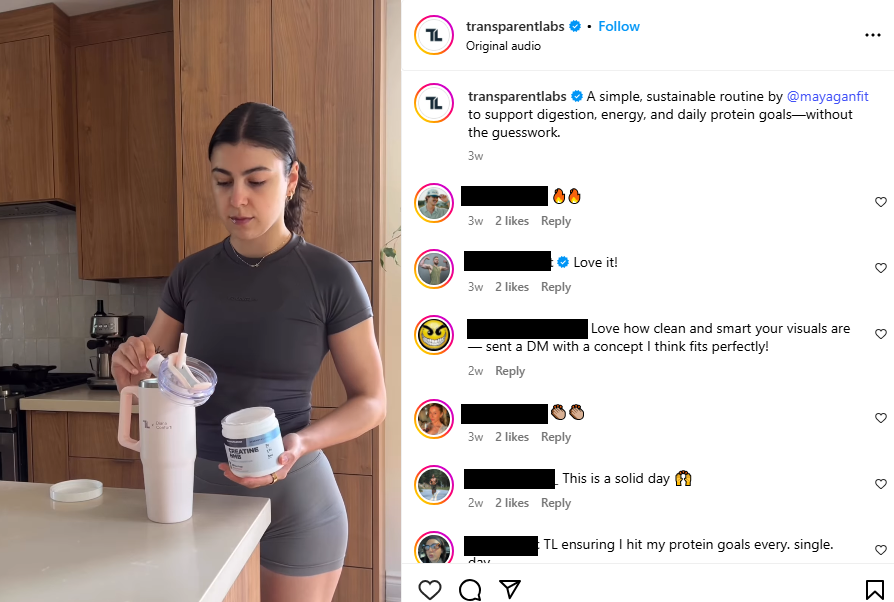
The result? The product feels fresh, even if it has been part of their stack for years. And because it is a limited run, there is urgency – people actually want to try it before it is gone.
Most gifts end when the box is opened. Big mistake. You can keep the experience going digitally with a QR code inside that links to a hidden landing page.
That page could include a personal message from your founder, a discount code just for their followers, early access to a drop, or even a “secret” giveaway they can share.
It turns a physical gift into a mini successful influencer gifting campaign, and makes the influencer feel like they are part of something more.
Try this:
Why send one gift when you can send two and double the excitement?
You can team up with another brand that shares your audience demographics but isn’t a direct competitor. Your skincare brand + a wellness tea company. Or your jewelry brand + a trendy stationery company. It makes the gift feel bigger, more thoughtful, and way more shareable. Influencers love unexpected pairings.
Bonus: you both get exposure to each other’s networks. One package, double the reach.
Try this:
Most brand notes are robotic. “Thank you for being part of our journey. We hope you enjoy this gift.” Ugh. Nobody’s posting that.
But a real, off-the-cuff, human-sounding note is way more powerful. Write it like you would talk to a friend. Mention something specific about the influencer. Let it be messy. Let it sound real. That is what connects.
Influencers remember brands that feel human. And yes, your handwriting matters more than your logo here.
Try this:
Many brands send a gift, cross their fingers, and then… nothing.
You need a follow-up, but not a boring “Just checking if you got the box!”
Instead, give them a fun, zero-pressure idea for how to share it. While influencers want creative freedom, who wouldn’t like it if they didn’t have to think too hard about what to say? It should feel helpful, not pushy.
Try this:
Everyone sends gifts for Christmas. Boring. Predictable. Oversaturated.
But a “Happy Mercury Retrograde Survival Kit” or a “National Self-Care Day” bundle? Now that is different. Influencers love tapping into quirky or seasonal themes. It gives them an instant hook for content.
Micro-holidays and cultural moments make your gift feel timely and clever, even if the gifted products themselves aren’t new.
Try this:
Now, just because you are not selling skincare or the latest gadget doesn’t mean influencer gifting isn’t for you. Take GetSafe, for example – proof that even so-called “unsexy” products can totally win at this.
In industries like elder care, where trust matters more than branding, emotional connection is the brand. If done right, even a medical alert system can generate content that feels real and gets shared. Want to see how? Let’s break it down.
Medical alert devices aren’t exactly trending on TikTok. They are not flashy, they are not cute, and they are definitely not what most influencers race to unbox.
But that is what made GetSafe such a standout. Instead of treating their product like a boring necessity, they built a gifting moment around what it really represents: peace of mind.
They reached out to lifestyle influencers not the typical Gen Z set, but ones who talk about caregiving or aging parents from a family-first lens.
Around National Caregivers Day, GetSafe sent out thoughtful “Care Kits” that included their device, plus a few add-ons like a handwritten note about aging with dignity and a framed quote about taking care of those who took care of us.
It turned something clinical into something deeply human. And it worked.
Several creators shared emotional posts, not just about the kit, but about their own caregiving journeys. The comments were full of gratitude, stories, and saves. More importantly, it sparked real conversations around safety and what it means to care for loved ones, exactly the kind of impact most brands only hope to make.
Every time you send a gift, you start from scratch. Not efficient.
Instead, build a private list of creators who actually love your brand and have posted about gifts without being asked. This is your gifting VIP list.
Use it to regularly surprise them with cool drops, exclusive previews, or seasonal gifts, without pitching anything. You are nurturing long-term loyalty, not chasing one-time posts.
Try this:
Bonus move: Give them early access to drops or private discount codes they can share (or keep).
This one is a total under-the-radar move: send a second gift, not for the influencer, but for someone (or something) they care about. Think of their kid, partner, best friend, or dog.
When you include someone from their real life, it instantly feels more thoughtful and way more shareable. It is unexpected. It is personal. And it turns a simple gift into a full-blown moment.
Try this:
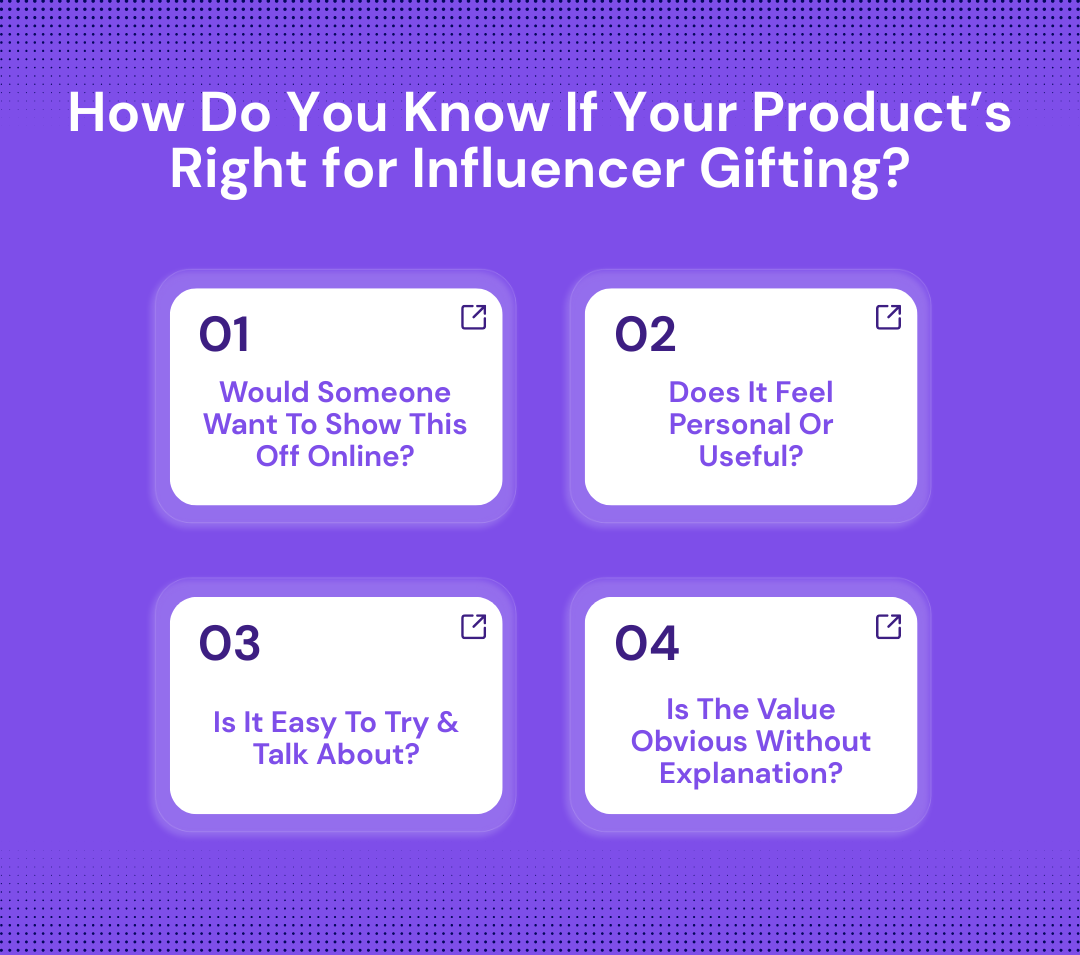
Before you start boxing up products and sliding into DMs, pause. Influencer gifting can be powerful, but it only works if your product actually makes sense for it. So, how do you know if your product is a good fit? Start here:
That is the first filter. Is your product photogenic? Interesting? Fun to unbox? If it is not something an influencer would naturally want to share, gifting probably won’t get you much traction. (No one is doing a TikTok unboxing of printer ink.)
Products that solve a real problem, fit their lifestyle, or spark a personal reaction tend to get shared. Bonus points if there is an emotional connection – something they can talk about, not just show off.
If your product needs a user manual or a 3-week trial period to be appreciated, it is not ideal for gifting. Influencers usually post first impressions, not in-depth reviews, so make sure your product delivers something right away.
The moment they open it, it should feel like a win. If you need to explain why it is special in a 500-word email, it is probably not going to land.
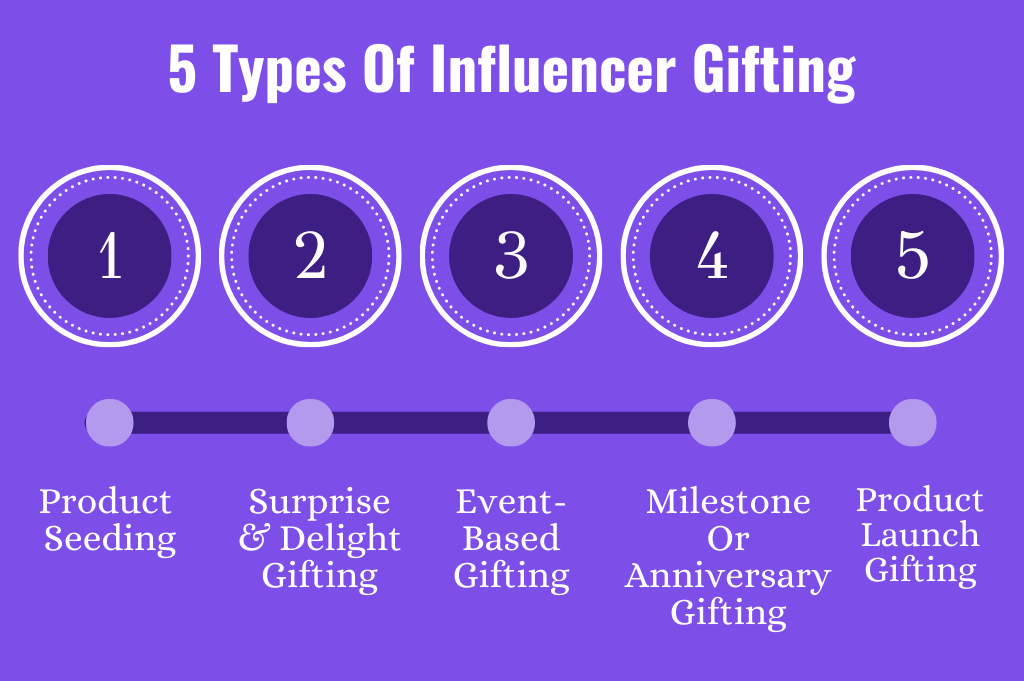
With 75% of people using social media for purchasing advice, influencer gifting is a serious growth lever. But if you are treating every gift like a “spray-and-pray” moment, you are probably wasting good products on bad timing. Each type of gifting has its purpose and best use case. Let’s break them down:
This is your “starter move.” You send products for free, usually with no ask, just to get your brand in front of people.
When to use it:
This is all about the positive experiences. You send something thoughtful or just plain fun – no announcement, no agenda.
When to use it:
Tied to a specific date, like Valentine’s Day or the first day of fall.
When to use it:
It adds a more personal touch. You celebrate them. Birthday? First collaboration anniversary? Hit 10K followers? Send something.
When to use it:
This is the “go big” moment. You have a new product, and you want people talking.
When to use it:

If you are thinking influencer gifting is just another version of influencer marketing, you are missing the point. When done right, gifting builds something financial compensation can’t always get: genuine excitement. Here’s what actually makes it work:
Gifting doesn’t come with a content brief or staged captions. So when someone posts, it is because they wanted to. That kind of real, unscripted reaction hits differently, and audiences can tell.
Posting once is easy. But gifting can be the start of something long-term. If they like what you sent, they will talk about it again without you asking. That is when you get the real ROI – repeat mentions, organic loyalty, maybe even inbound collaboration requests.
With paid partnerships, you often deal with managers, rates, contracts, and timelines. Gifting skips all of that. You get straight to the creator, and sometimes (if your gift lands right), you get authentic content created faster than any campaign could have delivered.
86% of US adults spend over 6 hours online every day. That is a lot of scrolling and a huge opportunity for your product to show up again and again. So, it all comes down to how many influencers you engage. Even if it is not sponsored, the audience perception is: “This brand is everywhere right now.” That is powerful, especially if you are looking to reach new audiences.
Most brands are still doing boring outreach. But a personalized, unexpected gift sticks. Even if they don’t post, it leaves a lasting impression. And when they do need a product like yours, guess who is top of mind?
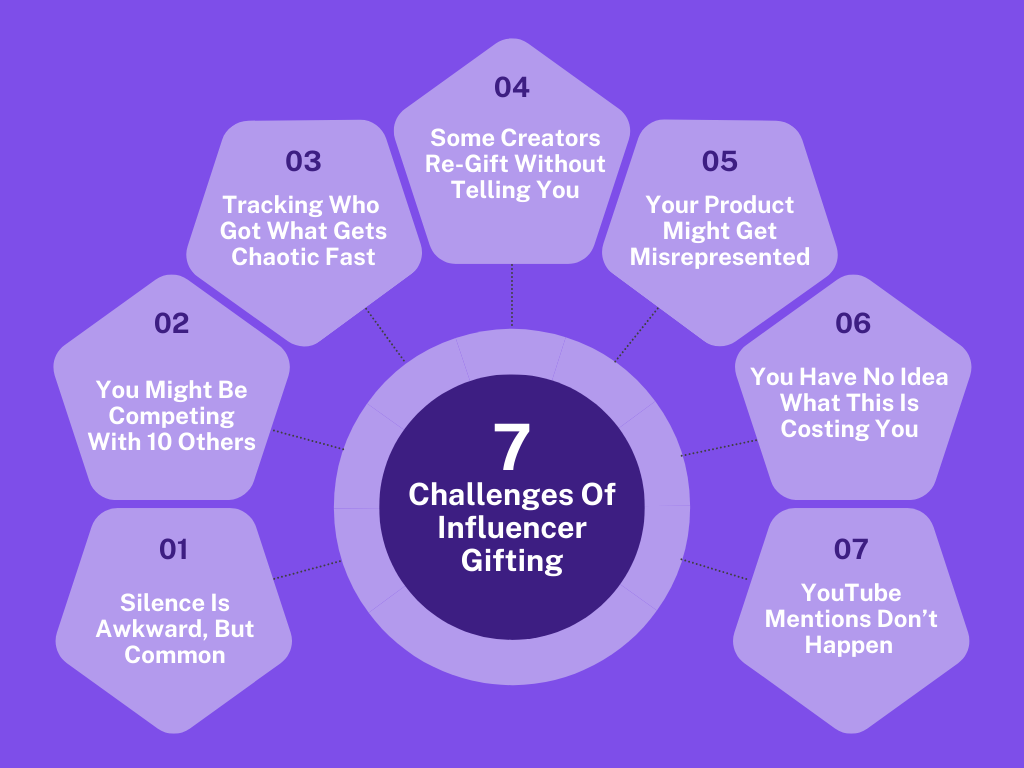
Influencer gifting sounds simple on paper, but behind the scenes, the entire process can get messy fast. Not because it is hard, but because no one really talks about the weird little things that trip brands up. So let’s do that.
You sent the gift. You tracked the delivery. And then... nothing. No story, no tag, no reply. It sucks, but it doesn’t always mean they hated it. Life happens. Maybe it never reached. Maybe they are waiting for better lighting. Either way, silence isn’t always rejection.
How to handle it: Give it a week. Then follow up casually, without guilt-tripping. Use a gifting platform for tracking and fulfillment. If you are managing several influencer relationships at once, hiring a social media expert can make your life easier. They know how to read the room and they will keep your brand from looking desperate or disconnected. This also allows you to ensure consistency, which is hard to maintain if you are handling 10 roles already.
Influencers get gifted a lot. If you are sending during peak PR season (like holidays or big event months), your gift might just get buried in the pile.
How to handle it: Time your gifting smarter. Try off-season drops. Or theme it around something personal (their birthday, niche moments, etc.) to cut through the clutter.
When you are sending out 5–10 gifts at a time, it is easy. But once you scale, people forget who got what, when, and whether they ever posted.
How to handle it: Set up a simple tracker. Nothing fancy – just name, handle, address, date sent, and any replies or posts. But if you are doing this at scale, bring in a developer to build a lightweight internal tool or even automate post tracking using APIs or webhook triggers from Instagram or TikTok tools.
Yes, it happens. You send something thoughtful, and it ends up with their cousin. Not every influencer treats gifting with care.
How to handle it: Watch their content closely after sending. If you see a pattern of zero acknowledgment, quietly move them off your gifting list.
Sometimes influencers show your product in a way that is off-brand, or worse, factually wrong. They might mispronounce your name or miss the key value altogether.
How to handle it: Create a short, optional “cheat sheet” card inside your gift with 2–3 fun facts, pronunciation help, or a quirky tip. No instructions, just helpful hints if they choose to post on their own social channels.
Gifting feels cheap compared to paid campaigns. No contracts, no invoices. But it adds up fast, and most brands don’t track the full cost. They forget to factor in labor, custom packaging, designer time, outreach hours, and follow-up. So when it is time to justify the spend, the numbers are a mess or worse, misleading.
How to handle it: If you are running influencer gifting alongside other marketing efforts, recruiting a financial expert is a smart thing to do. They will help you build a proper cost model and make sure you are not quietly bleeding budget. Plus, they will know how to compare gifting against paid collabs or ads, so you know exactly where to double down.
You sent the gift. They loved it. Maybe they even posted a quick story. But that full YouTube feature you were hoping for never happened. And it is not because they weren’t interested – it is because YouTube takes planning, scripting, filming, editing… and most influencers already have a backlog of content to get through.
How to handle it: If your product needs a proper demo or a “how-to” angle, YouTube is a goldmine if you support the creator properly. That doesn’t mean writing a script; you just have to remove friction. You can send over a quick B-roll clip of the product in use or offer access to YouTube editing services. Yes, some brands are actually offering editing help, and it works. Because the easier you make it for a creator to include you in their content, the more likely they will do it.
Influencer gifting feels intangible, but you can measure ROI against your campaign goals if you track the right numbers. Here’s how to calculate the engagement rates and return on your influencer gifting campaign.
Let’s say:
Total cost per influencer = $25
Cost for 10 influencer partners = $25 × 10 = $250
Let’s say 6 out of 10 post, and you gather:
Assume $15 CPM (cost per thousand impressions):
EMV = (70,000 × $15) ÷ 1,000 = $1,050
Say 20 total sales came from the gifted creators, and each product sells for $50:
Revenue = 20 × $50 = $1,000
ROI = (Total Value – Cost) ÷ Cost × 100
ROI = ($1,050 + $1,000 – $250) ÷ $250 × 100 = 720%
Even if only half the influencers post, it is still cost-effective, and you get a strong ROI if you track properly.
Most brands are still treating influencer gifting like a numbers game: send more, hope harder. That is why they get ignored. But you are not doing that anymore.
Now you have 11 influencer gifting strategies that are built to actually spark engagement from product gifting campaigns, not just deliver products into a black hole. Use one or two that fit your brand voice. Don’t copy-paste. Don’t mass blast. Make it feel intentional, every single time.
And it all starts with finding the right influencers. That is where SARAL makes life 10x easier.
Instead of digging through Instagram manually, SARAL helps you find, reach out to, and manage niche creators – all in one place. You can track who posted, who didn’t, and who is worth sending to again. No spreadsheets. No chaos. Just clean, trackable progress of influencer-generated content.
Start your free trial here and make the most of your influencer marketing strategy.
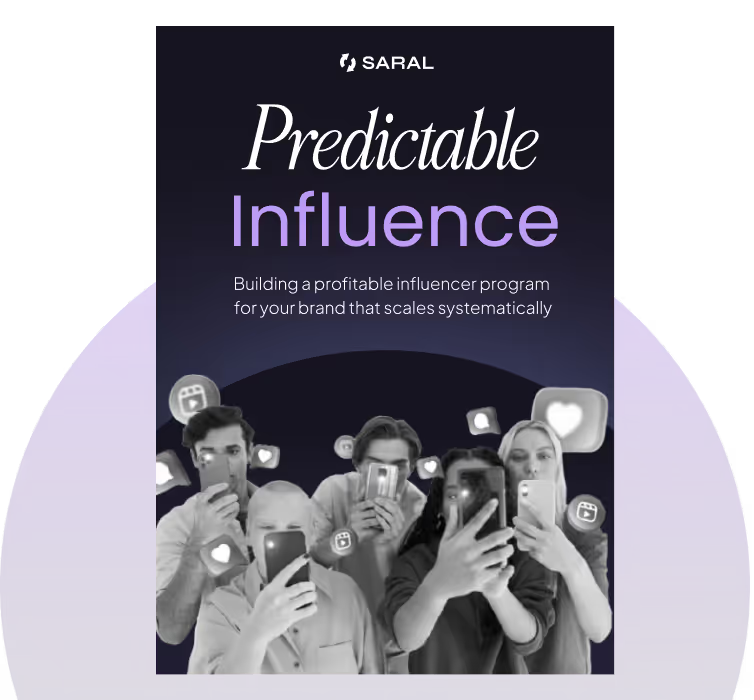
Sign up for a 7-day email course on the unique "Predictable Influence" strategy used by top brands like Grüns, Obvi, Tabs Chocolate.

If ditching the randomness of influencer campaigns and building a predictable, ROI-first influencer program sounds like a plan. Consider talking to our team!